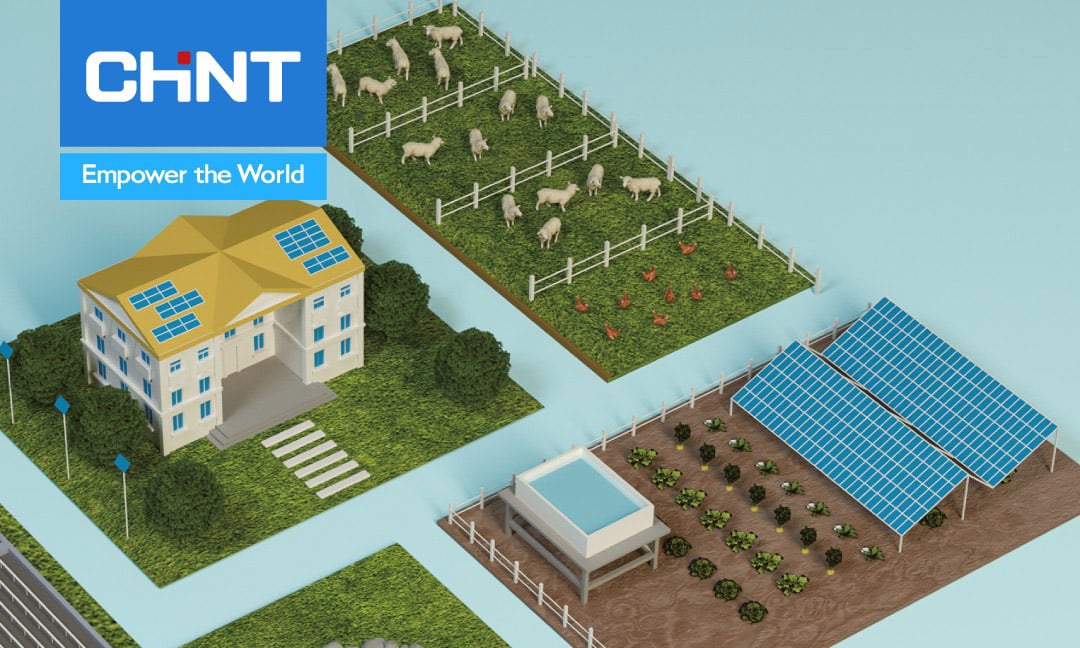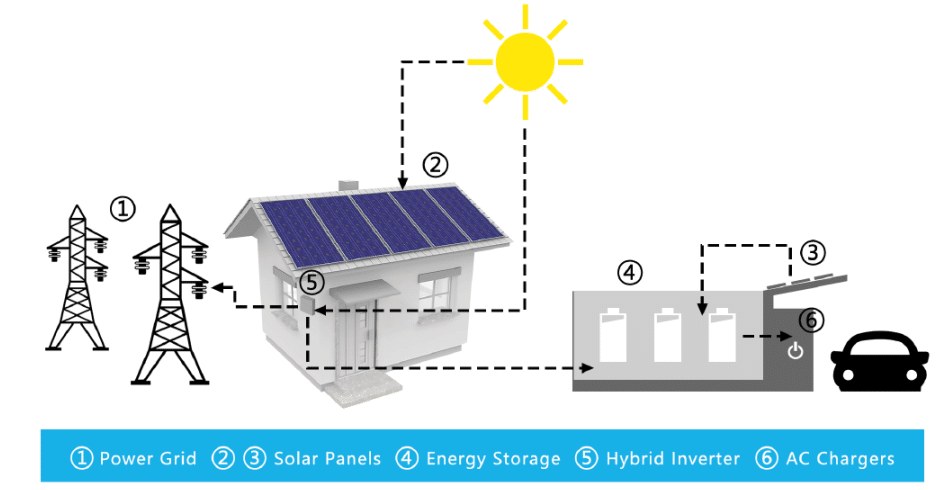Table of Contents |
As more and more people are looking for ways to become more self-sustainable to promote an eco-friendlier planet, solar energy sources have been a prime solution. Hybrid solar systems are a great innovation that allows homeowners to harness free energy created by the sun and utilize it to help supplement their home’s electricity demands throughout the year.
What is a Hybrid Solar System?
A hybrid system provides you the benefit of having battery storage for the solar energy that you produce while still being connected to the public electricity grid. This makes it the perfect type of system for supplying your electricity needs whenever you’re dealing with a power outage on the public electricity grid.
Each hybrid system will have four main components to work properly. These include solar panels, solar inverters, batteries, and electricity switchboards. Most people are familiar with photovoltaic cell panels placed either on top of the roof or mounted on a frame that rests on the ground in areas where sunlight is typically present. The whole job of these panels is to harness the energy coming from the sun.
Once the panels harness the energy, it’s in the form of direct current, or DC for short. Since all household appliances run on alternating current or AC electricity, your solar inverter is responsible for converting that DC electricity to AC electricity. Once your solar inverter has created AC electricity, it is sent to the electricity switchboard, where it’s determined how the energy is used.
The switchboard allows your household appliances and circuits to utilize the energy, send it to one of your solar batteries for storage, or feed it back into the public grid to provide you with some extra cash. For a hybrid system, you’ll have at least one battery for solar energy storage at your home.
While there are different types on the market, the whole point of the battery is to store that solar energy so that you can utilize it at times when your system is not producing any new energy and you don’t want to or can’t draw on the public electricity grid.
Hybrid Systems vs. On-grid Systems vs. Off-grid Systems
Hybrid energy systems are highly popular because they provide a great median between on-grid and off-grid systems. Traditional on-grid solar systems simply utilize solar energy to help provide electricity for your home. However, one of the pitfalls of an on-grid system is that it doesn’t have battery storage. Once the sun goes down or it’s a very overcast day, you’ll still need to rely on the main public electricity grid to provide Power for your home.
When it comes to an off-grid system, it requires much costlier equipment and an area for large battery storage so that you can power your home around the clock without any reliance on the public electrical grid. A hybrid energy system is situated in the middle and gives you the best of both worlds.
With this hybrid system, there is battery storage where you can hang on to some of that solar energy that you’re harnessing to help power your home at times when solar energy cannot be produced. Even better, a hybrid energy system is still connected to the public grid, which allows your home to receive public electricity whenever you run out of battery storage and cannot produce solar energy, such as in the middle of the night when the sun is down.
How Does a Hybrid Solar System Work?
A hybrid system is essentially a renewable energy system that utilizes solar panels to generate clean energy to power your household. It all starts with solar panels being exposed to sunlight to collect energy. These panels are able to harness the sun’s energy for their special photovoltaic cells.
Once energy is harnessed by the solar panel, it’s in the form of direct current energy. Since all of our households run on alternating current, a solar inverter is a necessary part of your hybrid energy system that converts that raw direct current into usable alternating current.
When your system is producing more energy than your household is currently using, that excess energy will be sent via the switchboard to your battery. This battery will hold the solar energy until you need it. Most of the time, this will be whenever the sun goes down, and you’re not able to produce solar energy but still need to run your appliances.
This is also helpful when the public grid has a power outage. You’ll still be able to rely on your solar battery to power your household’s electricity needs whenever it cannot harness energy from the sun, such as in the evening hours.
What is Needed for a Hybrid Solar System?
Any good hybrid system will have at least four main components. These are solar panels, the solar inverter, the switchboard, and battery storage. Solar panels are the most prominent part of the hybrid system as they’re commonly exposed on the roof of a house or in a yard.
Depending on where you get the most sunlight on your property, you’ll need solar panel mounts designed for your roof or your yard. The solar inverter, switchboard, and battery are typically hidden out of sight and don’t take up as much space as the panels do.
Pros and Cons of a Hybrid Solar System
When comparing the different types of solar energy systems out there, hybrid systems come along with their own pros and cons that any customer should be aware of. The main advantage of a hybrid system over other options is that it allows you to not only harness energy from the sun but store that energy for times when you need it most.
Additionally, since a hybrid system is still connected to the public utility grid, you cannot only make money on excess energy that your system creates, but you can also tap into using the public grid whenever you run out of energy stores.
However, it is important to note that hybrid systems are going to be slightly more expensive than your traditional on grid solar systems due to their added power backup system and battery storage.
Is a Hybrid Solar System Right for Me?
Deciding whether or not a hybrid type of solar system is best for your home comes down to assessing a few different key factors. These include your location, how much energy your home consumes, your budget, and your overall personal preferences. Hybrid energy systems are very popular for homeowners because they provide all the benefits of an on-grid system, with some of the benefits of an off-grid system.
This type of system can be particularly beneficial if you live in a geographical location where you experience blackouts on a consistent basis. This is simply due to the fact that the hybrid system will have battery storage and a backup power system to help keep your household running whenever the public grid is down.
However, it’s also important to keep your budget in mind when it comes to purchasing your solar energy system. Hybrid systems are costlier than traditional on grid systems.
Conclusion
Choosing to invest in a solar energy system for your home can be a great way to help save money on power bills and create a more self-sustainable life for you and your family. When it comes down to choosing the right type of solar energy system, hybrid systems tend to be the most popular and versatile for households.
If you’re considering investing in a solar energy system, then you need to check out Chint Global’s large solar energy product lineup. From solar photovoltaic panels to solar energy inverters, they have you covered from start to finish.
FAQ about Hybrid Solar System
What is the difference between solar system and hybrid solar system?
How much does a hybrid solar system cost?
Is a hybrid solar system the same as an off-grid solar system?














